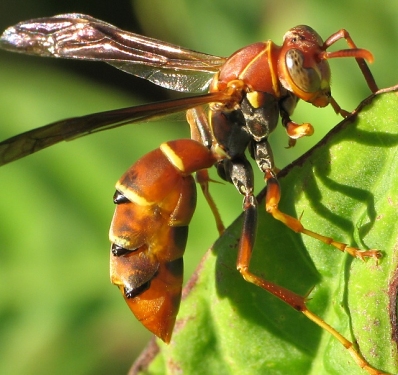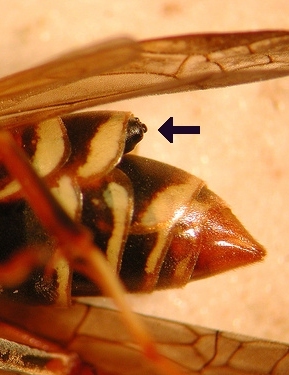| The Alien Lives of Parasites: Part One |
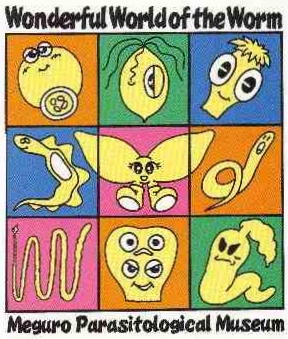
Degenerate. Lowly. Primitive. These are terms which, to many people, are immediately
brought to mind by the word "parasite." Even science was once guilty of labeling
parasitic life as a sort of "de-volution," a slothful step back for creatures that couldn't cut it
on their own. Little did we realize, survival in the body of another creature entails extreme
adaptation which, more often than not, surpasses the sophistication and craftiness of any
"free living" life-form.
brought to mind by the word "parasite." Even science was once guilty of labeling
parasitic life as a sort of "de-volution," a slothful step back for creatures that couldn't cut it
on their own. Little did we realize, survival in the body of another creature entails extreme
adaptation which, more often than not, surpasses the sophistication and craftiness of any
"free living" life-form.
As you read this, every macroscopic animal
on this planet is harboring at least one
species of parasite in or on its body,
including yourself. With more discovered year
after year, parasitic species may easily
outnumber the non-parasitic, and their
tremendous importance to the ecosystem
becomes more apparent the more they are
observed.
Parasites have an influence on which
animals are preyed upon, which animals
mate and which animals evolve. There is
even strong evidence that a some or all
human behavior - our tastes in the opposite
sex, our sleeping habits, our every mental
quirk - is subtly manipulated by the
microorganisms that invade our bodies.
on this planet is harboring at least one
species of parasite in or on its body,
including yourself. With more discovered year
after year, parasitic species may easily
outnumber the non-parasitic, and their
tremendous importance to the ecosystem
becomes more apparent the more they are
observed.
Parasites have an influence on which
animals are preyed upon, which animals
mate and which animals evolve. There is
even strong evidence that a some or all
human behavior - our tastes in the opposite
sex, our sleeping habits, our every mental
quirk - is subtly manipulated by the
microorganisms that invade our bodies.
In part one of this article, I'll be detailing my three choices for the most bizarre, most
amazing parasites you may have ever heard of. I know you're excited. Let's start off with
an old favorite...
amazing parasites you may have ever heard of. I know you're excited. Let's start off with
an old favorite...
| -LEUCOCHLORIDIUM PARADOXUM- |
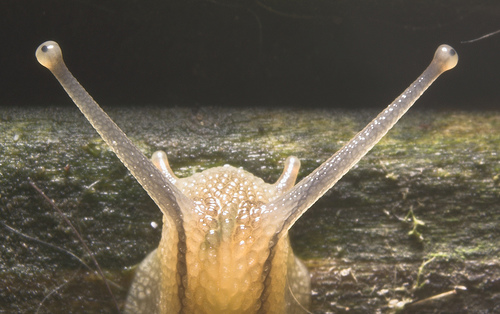
Imagine, if you will, the everyday life of a garden snail. Primarily nocturnal, you
avoid the dessicating rays of the sun as you slither in the shadows under dense
foliage, eating anything chewable you find in your slimy path. One day, you catch a
whiff of fresh bird droppings; to you, a delicious and nutritious meal. Days later,
however, you start to feel strange - at least as strange as your incredible simple
nervous system can muster - and against all logic, you feel attracted to the hot,
bright daylight your kind has spent millions of years hiding from. You go about your
snaily business as you always would, but this time, you're completely exposed, both
to the sun and to the eyes of hungry birds. Your foul tasting slime has taught most
avians that snails are an unappetizing meal, but unfortunately for you, you no longer
look like a normal snail.
avoid the dessicating rays of the sun as you slither in the shadows under dense
foliage, eating anything chewable you find in your slimy path. One day, you catch a
whiff of fresh bird droppings; to you, a delicious and nutritious meal. Days later,
however, you start to feel strange - at least as strange as your incredible simple
nervous system can muster - and against all logic, you feel attracted to the hot,
bright daylight your kind has spent millions of years hiding from. You go about your
snaily business as you always would, but this time, you're completely exposed, both
to the sun and to the eyes of hungry birds. Your foul tasting slime has taught most
avians that snails are an unappetizing meal, but unfortunately for you, you no longer
look like a normal snail.
Those droppings you ate were swarming with the eggs of the parasitic nematode,
Leucochloridium. Invading your simple little snaily brain, the worms have completely
rewired your behavior, and with their colorful, pulsing "brood sacs" crammed into
your eye-stalks, your head now resembles a couple of fat, juicy insect larvae - every
bird's favorite.
Leucochloridium. Invading your simple little snaily brain, the worms have completely
rewired your behavior, and with their colorful, pulsing "brood sacs" crammed into
your eye-stalks, your head now resembles a couple of fat, juicy insect larvae - every
bird's favorite.
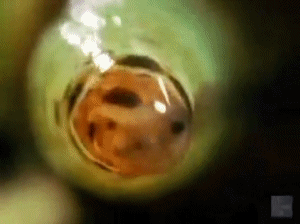
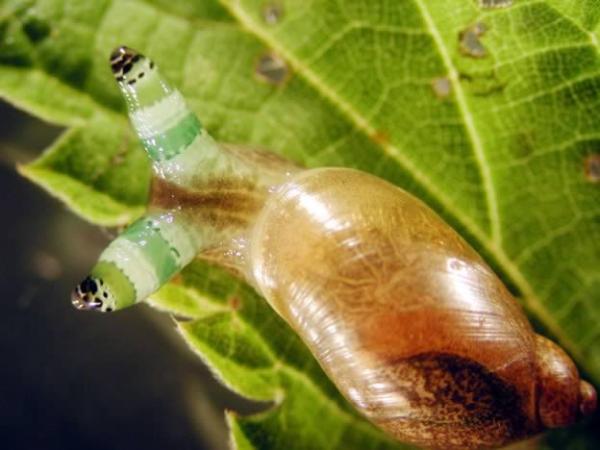
You'll likely survive your eyestalks being ripped off, and eventually, your entire face
will grow back...as will the parasites. You're lucky evolution never granted you the
intellect to comprehend your new existence, enslaved by a worm in your brain to
have your eyes chewed off again and again.
will grow back...as will the parasites. You're lucky evolution never granted you the
intellect to comprehend your new existence, enslaved by a worm in your brain to
have your eyes chewed off again and again.
| -SACCULINA- |
The "insects" of the sea, Crustaceans come in all manner of curious shapes and
sizes, adapted to a wide array of aquatic environments. Few are so unusual as the
largely sedentary Cirripedia, more commonly known as the barnacles, and there is
surely no barnacle more unusual than genus Sacculina. Like the other Cirripedes, it
begins its life as a microscopic, free-swimming "nauplius," but rather than anchor in
place and feed on plankton for the rest of its life, a female Sacculina spend its youth
hunting for one of its fellow Crustacea; a crab several thousand times its own size.
sizes, adapted to a wide array of aquatic environments. Few are so unusual as the
largely sedentary Cirripedia, more commonly known as the barnacles, and there is
surely no barnacle more unusual than genus Sacculina. Like the other Cirripedes, it
begins its life as a microscopic, free-swimming "nauplius," but rather than anchor in
place and feed on plankton for the rest of its life, a female Sacculina spend its youth
hunting for one of its fellow Crustacea; a crab several thousand times its own size.
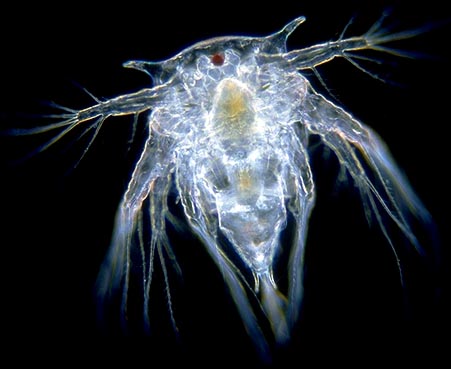
Once Sacculina locates a suitable host, it inserts a thin needle into a seam in the
crab's armor, injects its own cells into the host and discards the rest of its own
body. Now little more than a protoplasmic blob, it begins to grow through the crab
like a tumor, wrapping fungus-like tendrils around organs, muscles and even the
crab's eyes.
crab's armor, injects its own cells into the host and discards the rest of its own
body. Now little more than a protoplasmic blob, it begins to grow through the crab
like a tumor, wrapping fungus-like tendrils around organs, muscles and even the
crab's eyes.
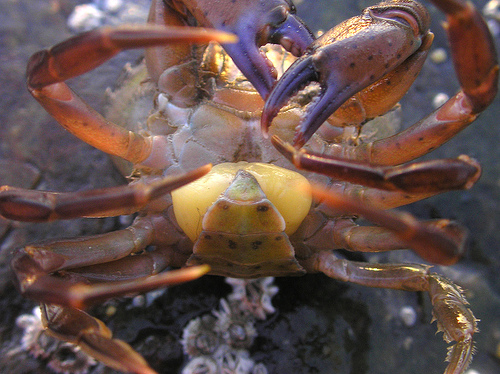
Soon, the intruder reveals its presence to the outer world as a bulging, blobby body
known as the externa, located where the host crab would normally carry a sac of
eggs. If the host happens to be male, the parasite simply alters its hormonal balance,
adjusting the crab's body and behavior to resemble that of an egg-carrying female.
known as the externa, located where the host crab would normally carry a sac of
eggs. If the host happens to be male, the parasite simply alters its hormonal balance,
adjusting the crab's body and behavior to resemble that of an egg-carrying female.
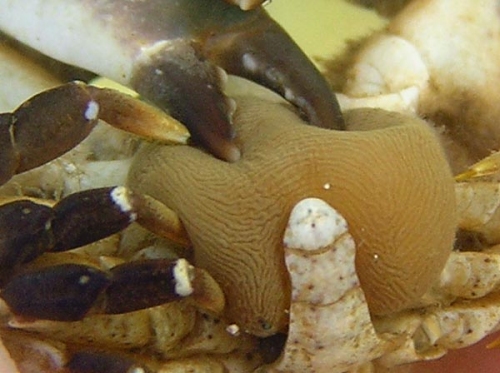
It is at this point that the male Sacculina finally enters the picture: Injecting itself into
the externa, it fertilizes the parasite's eggs, and the crab is induced to nurture them
as it would its own. Eventually, it will climb atop a rock or coral and shake its body in
the current, an action that would normally release thousands of crab larvae into the
surrounding water. The crab can never reproduce with its own kind, only continue to
raise the offspring of a cancerous invader.
the externa, it fertilizes the parasite's eggs, and the crab is induced to nurture them
as it would its own. Eventually, it will climb atop a rock or coral and shake its body in
the current, an action that would normally release thousands of crab larvae into the
surrounding water. The crab can never reproduce with its own kind, only continue to
raise the offspring of a cancerous invader.
| -The Strepsiptera- |
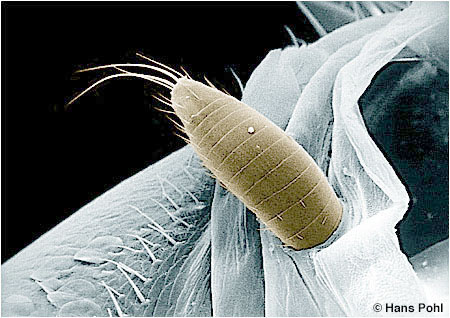
"Strepsiptera" translates as "twisted wing;" and wings aren't the only thing twisted
about this order of Insecta. As spiny, hopping larvae, they will either lie in ambush or
actively hunt for another insect to parasitize, with roughly 600 known species
specializing in different hosts including bees, beetles, cockroaches and even
silverfish. Once a larva locates its preferred target, it secretes a corrosive enzyme to
melt its way into the other insect's body, loses its legs and creates a protective
chamber out of the host's own tissues. If the parasite is female, this is how it shall
remain for the remainder of its existence.
about this order of Insecta. As spiny, hopping larvae, they will either lie in ambush or
actively hunt for another insect to parasitize, with roughly 600 known species
specializing in different hosts including bees, beetles, cockroaches and even
silverfish. Once a larva locates its preferred target, it secretes a corrosive enzyme to
melt its way into the other insect's body, loses its legs and creates a protective
chamber out of the host's own tissues. If the parasite is female, this is how it shall
remain for the remainder of its existence.
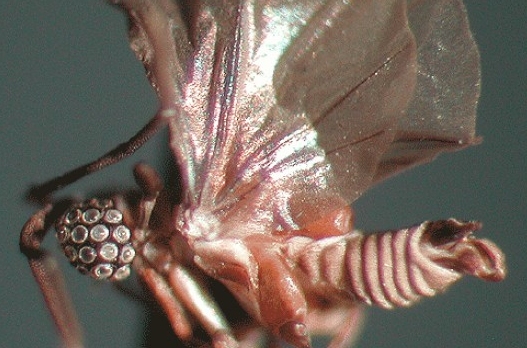
The mature female is easy to identify once you know where to look, as her head
protrudes noticeably from the exoskeleton of her host. It is through this end of her
body that she performs all reproductive functions, releasing a mating pheremone,
copulating, and depositing live larva all through an orifice in her face. Our species
can only imagine how it feels for a small, flying male to chase you down and have sex
with the head sticking out of your back, so remember to thank whatever merciful
creator you believe in that you weren't born a wasp.
Nor a crab.
Nor a snail.
protrudes noticeably from the exoskeleton of her host. It is through this end of her
body that she performs all reproductive functions, releasing a mating pheremone,
copulating, and depositing live larva all through an orifice in her face. Our species
can only imagine how it feels for a small, flying male to chase you down and have sex
with the head sticking out of your back, so remember to thank whatever merciful
creator you believe in that you weren't born a wasp.
Nor a crab.
Nor a snail.
If we're dealing with a male Strepsiptera, our parasite will eventually undergo
metamorphosis into the order's namesake, a delicate little insect with unusual
fan-like wings and even more unusual eyes, whose structure is partially shared only
by the long-extinct Trilobita. With a lifespan of only a few hours, the male is
unequipped to even feed at all, with his mouthparts modified into an array of sensory
appendages.
metamorphosis into the order's namesake, a delicate little insect with unusual
fan-like wings and even more unusual eyes, whose structure is partially shared only
by the long-extinct Trilobita. With a lifespan of only a few hours, the male is
unequipped to even feed at all, with his mouthparts modified into an array of sensory
appendages.
